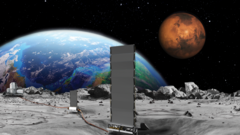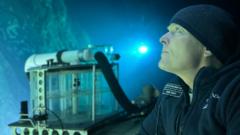Key discussions surround the feasibility and geopolitical motivations of this initiative amid a new space race.
**NASA's Ambitious Plans for Lunar Nuclear Reactor by 2030: A New Era of Lunar Exploration**

**NASA's Ambitious Plans for Lunar Nuclear Reactor by 2030: A New Era of Lunar Exploration**
As global interest in lunar exploration intensifies, NASA accelerates its plans for a nuclear reactor on the Moon by 2030.
NASA is poised to advance its Fission Surface Power Project, aiming to place a nuclear reactor on the Moon by 2030 as part of its strategy to establish a sustainable human presence on the lunar surface. This ambitious timeline, reported by US media outlets, comes in light of competitive gestures from nations like China and Russia, which have voiced similar plans and may soon claim exclusive zones on the lunar surface.
Acting NASA Administrator Sean Duffy emphasized the urgency of developing nuclear power technology for future lunar economies and national security, despite recent budgetary cuts that have led to skepticism surrounding the project's feasibility. Duffy invited commercial entities to submit proposals for nuclear reactors capable of generating at least 100 kilowatts—relatively modest compared to the power output of conventional energy sources.
Interest in lunar nuclear power is not entirely novel; in 2022, NASA engaged multiple companies with contracts worth $5 million to conceptualize reactor designs. Competing nations are similarly focused on lunar ambitions, with China's proposed automated nuclear power station expected by 2035. Leading experts agree that reliable power is critical for long-term lunar habitation, as lunar days consist of two weeks of constant sunlight followed by two weeks of darkness—making solar energy less reliable.
Experts like Dr. Sungwoo Lim argue that nuclear energy is not only needed but becomes inevitable for sustaining a human habitat on the Moon. Professor Lionel Wilson asserts that, with adequate funding and consistent program execution, launching nuclear reactors for 2030 is technically feasible, contingent upon NASA’s Artemis program that aims to establish infrastructure on the Moon.
Yet the discussion is not without its challenges, particularly regarding safety concerns associated with launching radioactive materials from Earth. Dr. Simeon Barber warns about the implications of launching such sensitive materials and the potential political motivations behind these accelerated plans in light of the renewed lunar race.
The potential for China and Russia to claim territory on the Moon adds another layer of complexity, as articulated by Dr. Barber, who notes that establishing a base or reactor could lead to exclusive claims over lunar regions. Tensions could rise over the interpretation of the Artemis Accords, an international agreement aimed at guiding cooperative lunar exploration, as nations navigate the complexities of shared space resources.
Overall, while NASA's aspirations for a nuclear reactor on the Moon showcase bold technological and exploratory ambitions, they also reflect a geopolitical landscape filled with uncertainty and competition. As preparations begin for Artemis 3, slated for a future lunar landing in 2027, experts encourage a holistic approach to ensure sustainable exploration aligns with the broader scientific objectives of space exploration.
Acting NASA Administrator Sean Duffy emphasized the urgency of developing nuclear power technology for future lunar economies and national security, despite recent budgetary cuts that have led to skepticism surrounding the project's feasibility. Duffy invited commercial entities to submit proposals for nuclear reactors capable of generating at least 100 kilowatts—relatively modest compared to the power output of conventional energy sources.
Interest in lunar nuclear power is not entirely novel; in 2022, NASA engaged multiple companies with contracts worth $5 million to conceptualize reactor designs. Competing nations are similarly focused on lunar ambitions, with China's proposed automated nuclear power station expected by 2035. Leading experts agree that reliable power is critical for long-term lunar habitation, as lunar days consist of two weeks of constant sunlight followed by two weeks of darkness—making solar energy less reliable.
Experts like Dr. Sungwoo Lim argue that nuclear energy is not only needed but becomes inevitable for sustaining a human habitat on the Moon. Professor Lionel Wilson asserts that, with adequate funding and consistent program execution, launching nuclear reactors for 2030 is technically feasible, contingent upon NASA’s Artemis program that aims to establish infrastructure on the Moon.
Yet the discussion is not without its challenges, particularly regarding safety concerns associated with launching radioactive materials from Earth. Dr. Simeon Barber warns about the implications of launching such sensitive materials and the potential political motivations behind these accelerated plans in light of the renewed lunar race.
The potential for China and Russia to claim territory on the Moon adds another layer of complexity, as articulated by Dr. Barber, who notes that establishing a base or reactor could lead to exclusive claims over lunar regions. Tensions could rise over the interpretation of the Artemis Accords, an international agreement aimed at guiding cooperative lunar exploration, as nations navigate the complexities of shared space resources.
Overall, while NASA's aspirations for a nuclear reactor on the Moon showcase bold technological and exploratory ambitions, they also reflect a geopolitical landscape filled with uncertainty and competition. As preparations begin for Artemis 3, slated for a future lunar landing in 2027, experts encourage a holistic approach to ensure sustainable exploration aligns with the broader scientific objectives of space exploration.



















